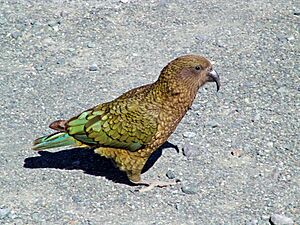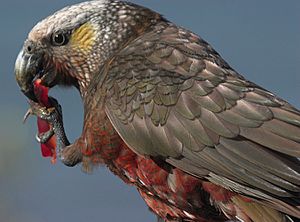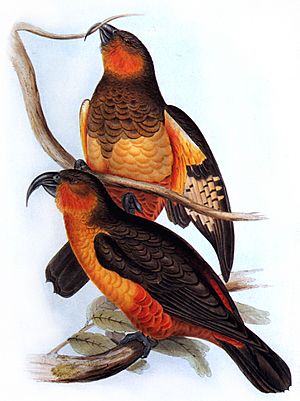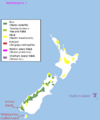Nestor (genus) facts for kids
Quick facts for kids Nestor |
|
|---|---|
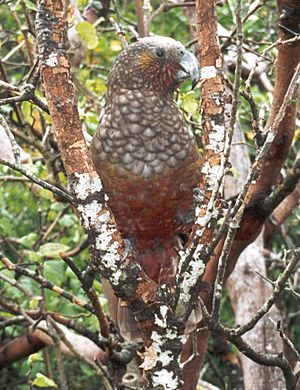 |
|
| New Zealand Kaka (Nestor meridionalis) |
|
| Scientific classification | |
| Kingdom: | |
| Phylum: | |
| Class: | |
| Order: | |
| Superfamily: | |
| Family: |
Nestoridae
|
| Genus: |
Nestor
Lesson, 1830
|
| Species | |
|
N. notabilis |
|
The genus Nestor is a group of amazing parrots found mainly in New Zealand. These birds belong to a special family called Nestoridae. Along with the Kakapo, they form a small group of parrots known as the Strigopoidea superfamily.
There are two types of Nestor parrots still alive today in New Zealand. Sadly, two other types of Nestor parrots from Norfolk Island, Australia, and Chatham Island, New Zealand, are now extinct. All the Nestor parrots are large, strong birds with short, square-shaped tails.
Contents
Meet the Nestor Parrots
There are two types of Nestor parrots that are still alive today, and at least one other type that is well-known but extinct. Not much is known about a fourth type, the Chatham kaka, which might have been the same as another kaka species.
Surviving Species
- Kea (Nestor notabilis): These clever birds are found in the South Island of New Zealand.
- New Zealand kaka (Nestor meridionalis): There are two types of Kaka:
- North Island kaka (Nestor meridionalis septentrionalis)
- South Island kaka (Nestor meridionalis meridionalis)
Extinct Species
- Norfolk kaka (Nestor productus): This parrot used to live on Norfolk Island but became extinct around 1851.
- Chatham kaka (Nestor sp.): This parrot lived on Chatham Island and became extinct between 1550 and 1700.
Types of Nestor Parrots and Where They Live
Let's learn more about each type of Nestor parrot!
The Kea
The Kea (Nestor notabilis) is about 48 centimeters (19 inches) long. Most of its feathers are olive-green, but it has bright scarlet (red) feathers under its wings and on its rump (the back part above the tail). Its feathers have dark edges, and it has a dark brown beak, eyes, legs, and feet. Male Kea usually have a longer beak than females.
Kea live in the South Island of New Zealand. You can find them in high-level forests and scrublands, usually between 850 and 1400 meters (about 2,800 to 4,600 feet) above sea level. They are known for being very curious and playful! Sadly, the Kea is considered a vulnerable species, meaning their numbers are decreasing.
The New Zealand Kaka
The New Zealand Kaka (Nestor meridionalis) comes in two main types: the South Island Kaka and the North Island Kaka.
South Island Kaka
The South Island Kaka (Nestor meridionalis meridionalis) looks a lot like its North Island cousin. However, it's a bit smaller and has brighter colors. Its crown (the top of its head) is almost white, and the males have a longer, more curved beak.
These Kaka live in the South Island of New Zealand. They prefer large areas of Nothofagus (beech) and Podocarpus (conifer) forests. In summer, they are found at higher elevations (450–850 meters or 1,500–2,800 feet), but in winter, they move to lower areas (0–550 meters or 0–1,800 feet). The South Island Kaka is an endangered species, meaning it's at high risk of extinction.
North Island Kaka
The North Island Kaka (Nestor meridionalis septentrionalis) is about 45 centimeters (18 inches) long. It's mostly olive-brown with dark edges on its feathers. It has crimson (deep red) under its wings, on its rump, and around its neck like a collar. Its cheeks are golden/brown, and its crown is grayish.
These Kaka live in the North Island of New Zealand. Like their southern relatives, they live in large areas of Nothofagus and Podocarpus forests. They also move between higher elevations in summer and lower ones in winter. The North Island Kaka is also an endangered species.
Extinct Parrots
Norfolk Kaka
The Norfolk kaka (Nestor productus) was about 38 centimeters (15 inches) long. It had mostly olive-brown feathers on its upper body, reddish-orange cheeks and throat, and a straw-colored chest. Its thighs, rump, and lower belly were dark orange.
This parrot used to live only on Norfolk Island and the nearby Phillip Island, which are part of Australia. It lived among rocks and trees. Sadly, the Norfolk Kaka became extinct by about 1851.
Chatham Kaka
The Chatham kaka (Nestor sp.) is only known from subfossil bones, which are very old bones that haven't fully turned into fossils. Because of this, we don't know what it looked like. However, the bones suggest that it might not have been able to fly very well.
This parrot used to live only on Chatham Island in New Zealand, in the forests there. It became extinct between 1550 and 1700.
Images for kids
See also
 In Spanish: Nestor (género) para niños
In Spanish: Nestor (género) para niños


